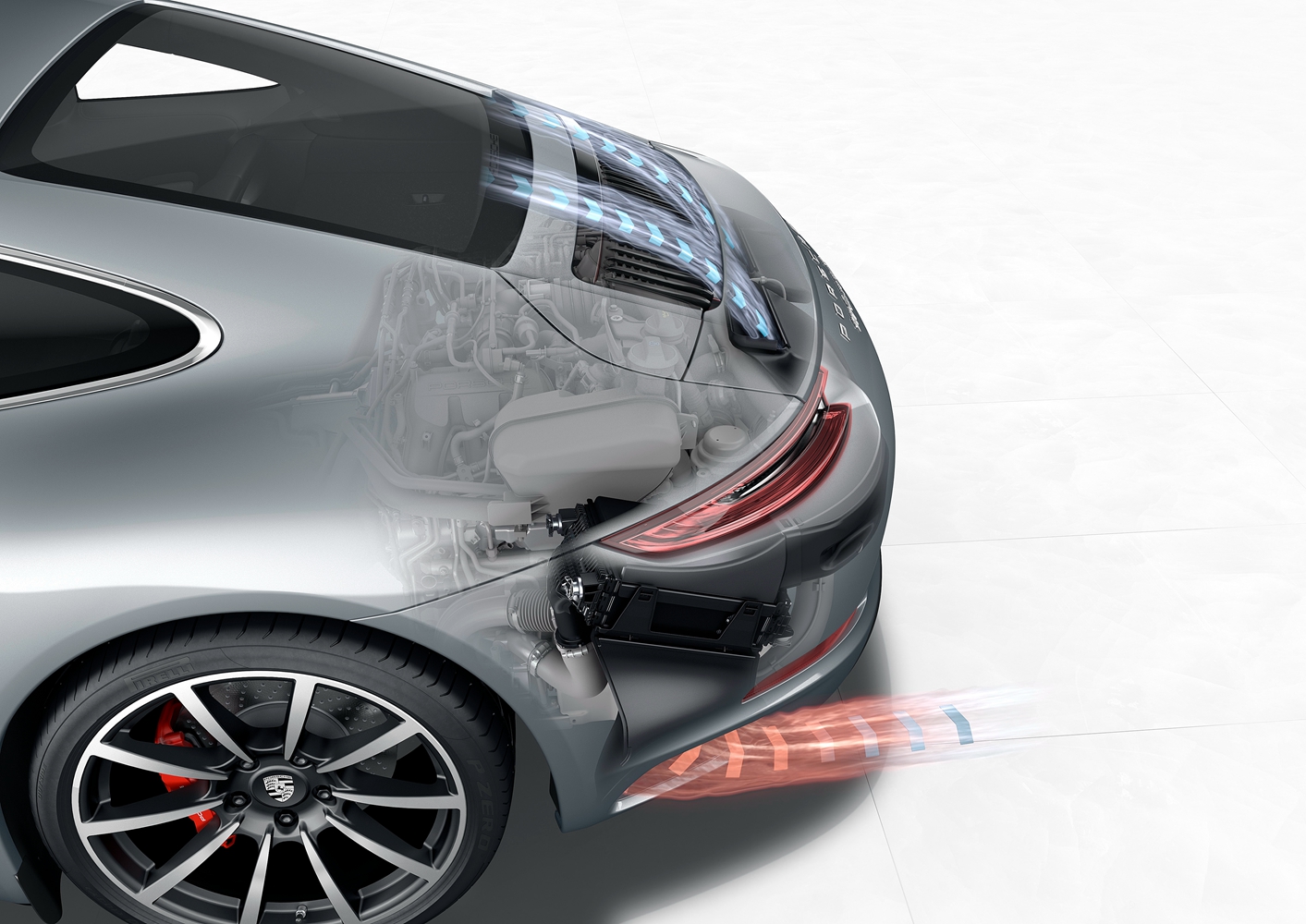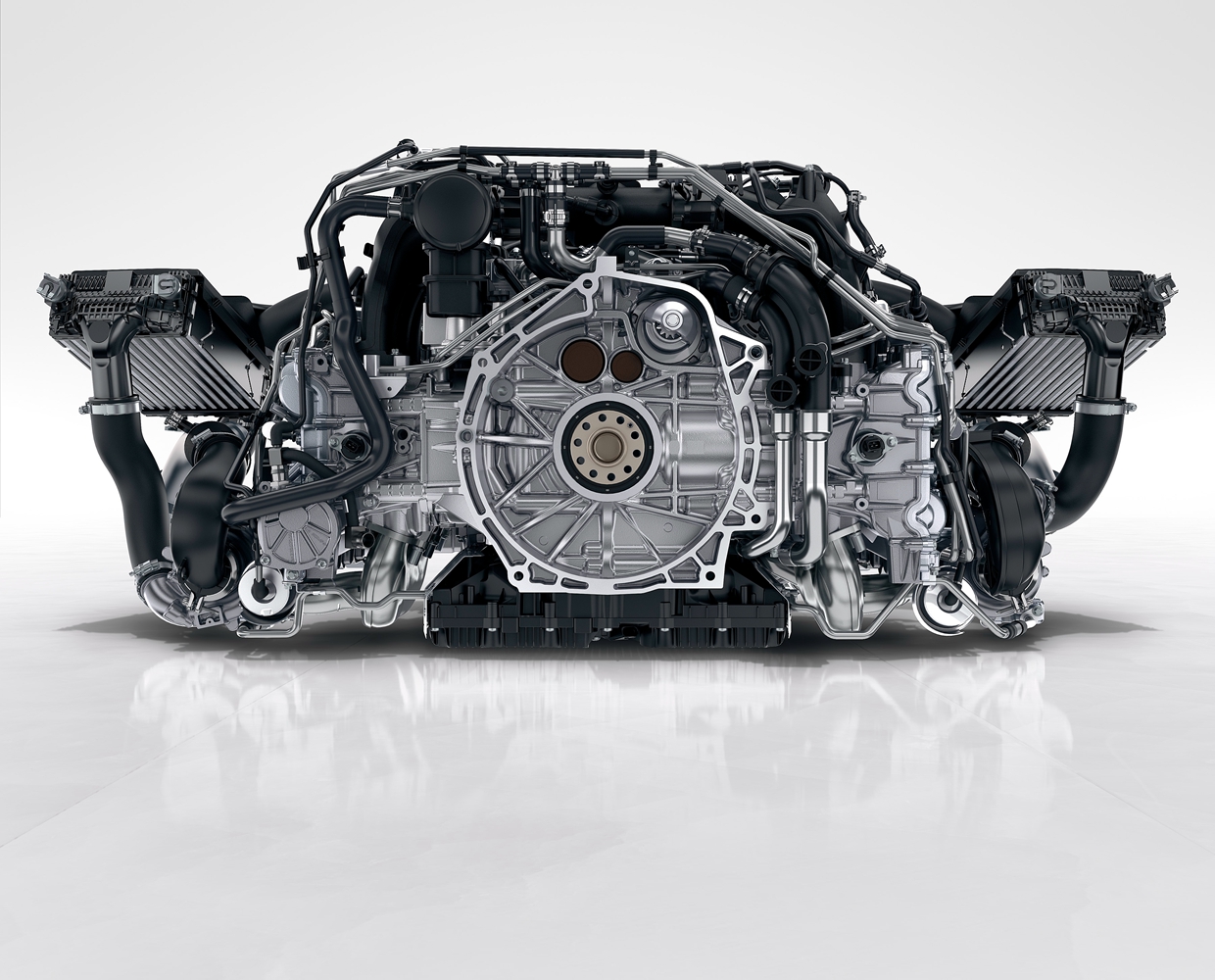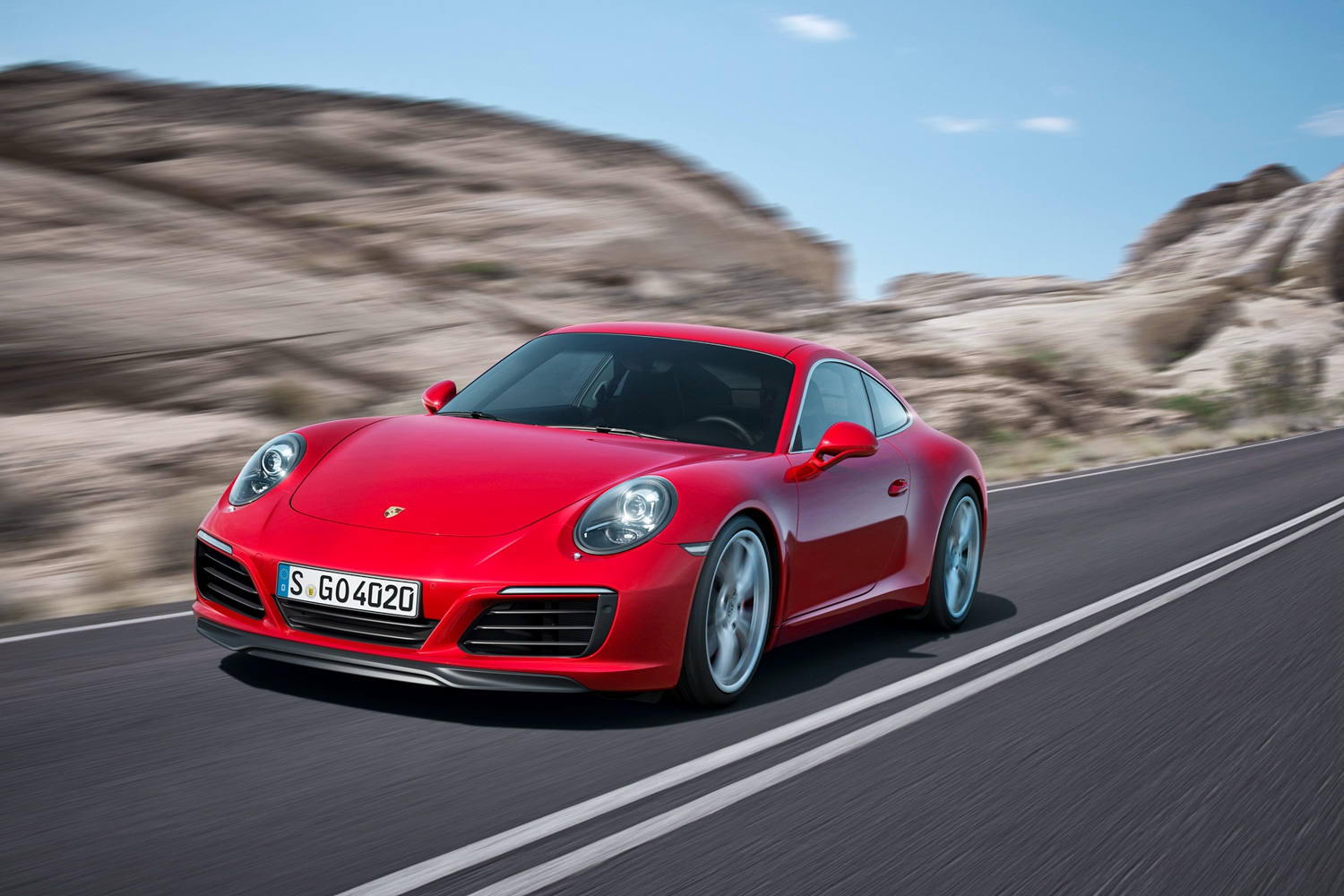 这张Carrera 2016版的半透视图显示出发动机的进气和排气管路与中间冷却器的位置。全新的3.0 L水平对置六缸发动机,在同样的排量下能提供比1974年 Turbo发动机高出42%的峰值功率。
这张Carrera 2016版的半透视图显示出发动机的进气和排气管路与中间冷却器的位置。全新的3.0 L水平对置六缸发动机,在同样的排量下能提供比1974年 Turbo发动机高出42%的峰值功率。 保时捷最新的水平对置六缸发动机包括以下新特性:等离子喷涂汽缸膛、经过减重曲轴箱、工程塑料油底壳、可在250 bar系统压力下工作的直喷装置等。水泵加装的离合器可在发动机工作时啮合,而在制冷剂温度较低时保持分离状态,以减小摩擦。
保时捷最新的水平对置六缸发动机包括以下新特性:等离子喷涂汽缸膛、经过减重曲轴箱、工程塑料油底壳、可在250 bar系统压力下工作的直喷装置等。水泵加装的离合器可在发动机工作时啮合,而在制冷剂温度较低时保持分离状态,以减小摩擦。 2016年保时捷911 Carrera Cabriolet的透视图。
2016年保时捷911 Carrera Cabriolet的透视图。 911新车型在造型上有一些细节修改,如全新的前大灯,但最重要的改变则是3.0 L双涡轮增压发动机。
911新车型在造型上有一些细节修改,如全新的前大灯,但最重要的改变则是3.0 L双涡轮增压发动机。
自1972年保时捷在威猛的917/10 Can-Am赛车上首次使用增压发动机以来,“保时捷”和“涡轮增压”这两个词就成了超高性能的同义词。在2016车型年里,保时捷将推出全新的涡轮增压3.0L水平对置六缸发动机,以代替目前在911 Carrera和Carrera S上使用的自然进气式3.4L和3.8L发动机。但名字中带有“涡轮增压”的911 Turbo仍将使用3.8L涡轮增压发动机。
3.0L Carreras将于2015年法兰克福车展上亮相。这款轻量化增压式水平对置发动机将使Carreras的效率和动力提升至全新的水平。Carrera的动力将增加15 kW (20 hp),峰值输出达到272 kW (365 hp)。Carrera S也将增加15 kW (20 hp),达到309 kW (414 hp)。这两款全新的发动机都将使用BorgWarner涡轮增压器,每排气缸组配备一台。
S版3.0L发动机改进了涡轮压缩机,特制了一个排气系统,并对发动机管理系统进行了调整。Carrera的增压为0.9 bar (13 psi), 而Carrera S为1.1 bar (16 psi)。新发动机还能产生更高的峰值扭矩,当转速从1700升至5000rpm时,两款的峰值扭矩分别可以达到450 N·m 和 500 N·m (331和368 lb·ft),较旧款增加了60 N·m (44 lb·ft)。两款发动机的最高转速都为7500 rpm。
Carrera和Carrera S的性能都得到了轻微提升,搭载PDK(双离合器变速箱)和跑车计时套件的Carrera S的百公里加速时间只需3.9秒,最高时速可达307 km/h (190 mph)。然而,得到提升的不仅是性能,燃耗与排放也明显改善不少。搭载PDK的S整车百公里耗油量为7.7L,比旧款少了1.0L。在二氧化碳排放方面,Carrera的公布数据为169 g/km,S为174 g/km。
保时捷技术发言人Nick Perry表示,这两款911新车型不会使用“Turbo”名号。因为在涡轮增压方面,超高性能的911GT系列“需要单独讨论”:“现有的Turbo将维持原状;这款车型的形象和特征与Carrera不一样。我们在Panamera、卡宴和Macan上都安装了涡轮增压,但Turbo只能用在里程最高的车型上。”
新发动机的内部情况
道路跟踪技术的转让是保时捷最重要的工程信条之一,但911赛车系列可以通过自然进气式发动机来达到法规要求。“我们的911赛车将继续使用自然进气式GTRS 4.0L发动机,” Perry解释道。“但路面车辆必须达到多种标准,因此我们正在开发新发动机。”
他将这台新发动机称作“阶跃变化”。3.0L发动机是一台全新的产品,而非3.4或3.8发动机的衍生物。这一举动的重要意义相当于保时捷在1998车型年采用的液冷技术。后者成功实现了降低驾驶噪音、提高性能与效率、提高发动机承受高温的能力、改进燃烧性能等目标。另一项阶跃变化则是2008年的直喷燃油技术。
至于包括博克斯特和Cayman在内的其他车型是否将使用3.0L新发动机,保时捷没有发表正式声明,但可以预见新车型会在未来登场。
新发动机中使用的压力感应技术要求在车辆后部配备一套全新的气流系统与中间冷却器,以辅助发动机的燃烧。首先,发动机将燃烧空气集中在后扰流板的前方,随后气流穿过空气过滤箱的两个水平出口,抵达通向下方涡轮增压器的两个感应通道。接着,经过压缩并加热的空气流经位于车轮拱罩后方水平放置的两个中间冷却器,并通过节流阀板向上抵达发动机的感应歧管。另外还有两根导管将高温燃烧空气导向中间冷却器(包括来自后部风挡的热空气)。
新发动机的喷射器位于燃烧室的中心,这样做可以提高燃烧效率。2个燃油泵为其注油,每排气缸组配备1个泵,运行时的系统压力最高可达250 bar (3626 psi)。可变尾气凸轮轴正时技术可以精准地控制增压交换。在进气方面,保时捷继续使用VarioCam Plus(可变气门正时与扬程)系统,对气门升程与开门时长进行调节。
此外,保时捷工程师还表示,新发动机采用了一种全新的汽缸壁表面加工技术,用等离子束在膛壁上喷涂铁涂层的工艺,有助于减少摩擦损耗。另外,工程师们在设计阶段进行了大量FEA分析后,成功将铝制曲轴箱的重量减轻了1.5 kg (3.3 lb)。采用工程塑料制作的全新油底壳也比旧款轻了2 kg (4.4 lb)。
新水泵上增添了一只由热管理系统控制的离合器,在冷却剂温度较低的时候可以保持脱离状态。不工作的水泵不再磨耗发动机的动力,因此冷却剂可以缓慢循环。减少的摩擦使发动机可以更快地到达工作温度。此外,空调压缩机也使用了这一机制,借助离合器来实现完全脱离。
可以转换模式的传动系统
为配合3.0L发动机的高扭矩,传动系统中引进了一个双盘离合器,以使运作更为流畅。而保时捷的PDK系统也采用了一套全新的工作逻辑。和911 GT3以及保时捷的其他赛车一样,驾驶员现在可以通过向后拉变速杆来选择升档,向前推选择降档。此外,保时捷还用具有离心摆的双质量飞轮、智能超速切断装置与“虚拟”齿轮和PDK搭配使用。
离心摆也可以在手动变速箱中使用。保时捷工程师解释,该装置的自适应减震器可以在大幅度的转速范围内吸收传动系统的振动。
除了跑车计时套件和PDK系统,911驾驶员还能享用一种全新的“模式转换”机制。该系统中新增的“跑车反应”按钮可以激活一个事先调整好的传动系统反应模式,使最大加速度持续长达20秒。在此状态下,齿轮啮合与发动机管理都调整到最佳状态,以最出色的自主反应模式应对超车等情况。
主动后桥转向与悬挂系统
为了配合传动系统的改进,保时捷911对底盘也进行了不少修改,其中包括主动后桥转向系统——这也是Carrera S的可选配置。该技术是在911 Turbo、911 GT3以及非911车系的限量版918 Spyder的基础上改进而成的。
主动后桥转向技术是专门为增强911的入弯性能而设计的,可将转弯半径减少0.5 m (1.6 ft)。保时捷目前使用的方向盘直径为360 mm (14-in),比之前短了15 mm (0.6-in)。
整个Carreras车系的2016版本都将使用保时捷的主动悬挂管理系统(PASM),底盘高度较先前低了10 mm (0.4 in)。可以选配的液压升降系统,通过位于前悬架的提升气缸将车辆离地间隙增加了40 mm (1.6 in),以应对车库内的陡坡和减速带等障碍。
保时捷表示,为Carreras引进涡轮增压发动机是合乎逻辑的下一步计划,符合已经延续了四十年的技术发展路线方向。1974年推出的首台Turbo涡轮增压发动机输出功率为194 kW (260 hp),每百公里消耗20.9 L高辛烷值汽油。与之相比,2016年最新版水平对置六缸发动机使用相同的排量,但功率却提高了42%,燃油经济性也高出2倍以上。这是多么惊人的进步!
作者:Stuart Birch
来源:SAE《汽车工程杂志》
翻译:SAE 上海办公室
Porsche unveils new downsized, boosted 3.0-L boxer six
The words “Porsche” and “turbo” have been synonymous with ultimate high performance since 1972, when the automaker first used boosted engines in the mighty 917/10 Can-Am racecars. For 2016MY, the company is introducing all-new turbocharged 3.0-L flat-six engines for the 911 Carrera and Carrera S road cars, replacing naturally aspirated (NA) 3.4-L and 3.8-L units. The 911 that carries the specific "Turbo" designation, however, will continue to use a 3.8-L engine.
The 3.0-L Carreras will be unveiled at the 2015 Frankfurt Motor Show. The downsized-and-boosted "boxer" brings new levels of efficiency and added power; the Carrera gets an extra 15 kW (20 hp) taking peak output to 272 kW (365 hp). The Carrera S produces 309 kW (414 hp), also a 15-kW improvement. The new engines use two BorgWarner turbos, one per cylinder bank.
The S version of the 3.0 L features modified turbine compressors, a specific exhaust system and tuned engine management. Boost pressure is 0.9 bar (13 psi) in the Carrera and 1.1 bar (16 psi) in the Carrera S. The new engine also produces more peak torque – an added 60 N·m (44 lb·ft), delivered from 1700 to 5000 rpm, to provide 450 N·m and 500 N·m (331 and 368 lb·ft), respectively. Both variants are rev-limited to 7500 rpm.
Performance of both the Carrera and Carrera S is slightly improved, the S fitted with PDK (dual clutch) and Sport Chrono Package achieving a claimed 0-100 km/h in 3.9 s, and top speed of 307 km/h (190 mph). But fuel consumption and emissions are markedly better; the S with PDK achieves a combined figure of 7.7 L/100 km, an improvement of 1.0 L/100 km. Claimed CO2 emissions are 169 g/km for the regular Carrera, 174 g/km for the Carrera S.
According to Porsche technology spokesperson Nick Perry, the new 911 models will not be badged “Turbo.” He also explained that the very high performance 911 GT variants were a “separate topic” with regard to the application of turbocharging: “The current Turbo will continue to be described as that; the model offers a different image and attributes to those of the Carrera. We have turbochargers in the Panamera, Cayenne and Macan, but there, too, we use the designation Turbo for top of the range versions.”
Inside the new boxer
Track-to-road technology transfer is a major element of Porsche’s engineering creed but its racing 911s have NA engines to meet regulations. “The NA GTRS 4.0-L engine will continue to power our 911s in the motorsport realm," Perry explained. "But for road cars there is a multitude of criteria to meet, which is why we are introducing the new engine."
He described the new engine as a "step-change"—the 3.0-L being all-new and not a derivative of the 3.4 and 3.8 engines. The move is similar to when Porsche went to liquid cooling (1998MY) to reduce drive-by noise, improve performance and efficiency, running the engines hotter and achieving better combustion. Another step-change came in 2008 with the introduction of direct fuel injection.
Porsche is making no formal comment about the new 3.0-L turbo family forming the basis of engines for other models ranges including the Boxster and Cayman, but siblings can be expected.
The use of forced induction has required a new engine airflow system for combustion and intercooling at the rear of the Carreras. The engine gets its combustion air centrally in front of the rear spoiler. From two lateral ports on the air filter box, the airflow reaches two induction channels to the lower-mounted turbochargers. The compressed and heated air then flows through two intercoolers located laterally behind the wheel arches and onwards to the engine's induction manifold via the throttle plate. Two other ducts guide the air for cooling the heated combustion air (also from the air screen in the rear lid) to the intercoolers.
The 3.0-L’s injectors are located in the center of the combustion chamber for greater combustion efficiency. They are fed by two fuel pumps, one per cylinder bank, operating on a system pressure of up to 250 bar (3626 psi). Variable exhaust-camshaft timing facilitates precise control of the charge exchange process. On the intake side, Porsche continues to use VarioCam Plus, adjusting both valve lift and opening duration.
A new cylinder wall coating process, in which a plasma beam coats the bore surface with iron, helps reduce friction losses, according to Porsche engineers. And extensive FEA analysis during the design process helped cut the weight of the aluminum crankcase by 1.5 kg (3.3 lb). A new engineered-plastic oil pan is 2 kg (4.4 lb) lighter than in the previous generation engines.
The water pump now has a clutch that is controlled by thermal management and can remain disengaged at low coolant temperatures. The deactivated pump no longer draws any engine power, and the coolant just circulates slowly. Friction is reduced and the engine reaches its operating temperature more quickly. The same applies to the air conditioning compressor; it can also be completely deactivated via a clutch.
Mode-switching drivetrain
Transmission developments include introduction of a two-disc clutch for the new engines for comfortable operation despite the new 3.0-L’s high torque. And the PDK has new operating logic. As in the 911 GT3 and many Porsche racecars, pulling the selector lever back now provides upshifting; pressing it forward triggers downshifting. Porsche is now using a dual-mass flywheel with a centrifugal pendulum in conjunction with the PDK, as well as intelligent overrun cut-off and "virtual" gears.
The centrifugal pendulum is also used with the manual transmission. It has an adaptive vibration absorber that dampens vibrations in the drivetrain over a broad range of engine speeds, according to Porsche engineers.
In combination with the Sport Chrono and PDK systems, the 911 driver now has a “mode switch” which has an additional “sport response” button which activates a pre-conditioned drivetrain response which provides maximum acceleration for 20 s, the optimum gear engaged and engine management adjusted for optimum spontaneous response such as for overtaking.
Active rear-axle steering and suspension
Complementing the new powertrain developments, chassis changes for the 911 include active rear axle steering as an option for the Carrera S, The technology is adapted from the 911 Turbo and the 911 GT3 as well as the exotic limited-production 918 Spyder.
The active rear axle is designed to enhance the turn-in behavior of the 911 and reduces the car’s turning circle by 0.5 m (1.6 ft). Porsche is offering a 360-mm-diameter (14-in) steering wheel that is 15-mm (0.6-in) smaller than the previous wheel.
Porsche Active Suspension Management (PASM) is fitted to all Carreras for 2016. It lowers ride height by 10 mm (0.4 in). An optional hydraulic lift system increases the car’s ground clearance by 40 mm (1.6 in) via lifting cylinders in the front suspension struts to clear steep garage ramps and speed bumps.
Porsche states that introducing turbocharging for the Carreras was a logical next step in a technology path that began four decades ago. The original Turbo engine of 1974 had a claimed power output of 194 kW (260 hp) and consumed 20.9 L of high-octane gasoline per 100 km. By comparison, the new-for-2016 flat six-cylinder engine produces 42% more power with more than twice the fuel economy, while using the same cylinder displacement. Progress all around!
Author: Stuart Birch
Source: SAE Automotive Engineering Magazine
等级
打分
- 2分
- 4分
- 6分
- 8分
- 10分
平均分
- 作者:Stuart Birch
- 行业:汽车
- 主题:动力与推进力
